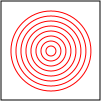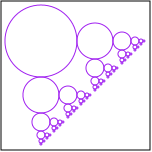Lab 3 ©2011 Felleisen, Proulx, Chadwick, et. al.
Designing Methods
3.1 Designing Methods for Classes
Remember the Rocket class you defined in the beginning of the last lab? Find the class definition and copy it into a new file for this lab. Rename your Posn class to Loc, so it doesn't clash with later exercises.
Design the following methods for the Rocket class (not the union, yet):
the method belowRadar that determines whether the height of this Rocket is below the given radar limit.
the method sameName that tells whether this Rocket has the same name as a given rocket. Hint: you'll need to use the boolean equals(String) method defined in the String class to compare the rocket names.
the method moveUp that produces a new Rocket with it's location moved up by 10 pixels. Note: this method also involves the design of a Loc method which returns a new Loc moved up by 10 pixels.
the method nowLanding that produces a new Rocket with its landing as true.
3.2 Designing Methods for Unions of Classes
Last lab we also designed an interface (IRocket) and classes (SelfFlying, DualEngine, and Toy) to represent different kinds of Rockets.
Design the method nasaApproved that determines whether this IRocket could be used in a future NASA mission. Obviously, only Toy rockets are not approved.
Design the method moveUp that returns a new IRocket with its location moved up by 10 pixels. Toy rockets don't have locations, so they can be returned unchanged.
3.3 Complex data definitions and methods
The following Racket data definition describes a representation of web sites:
;; A WebPage is:
;; (make-webpage String String [Listof Item])
(define-struct webpage (url title items))
;; An Item is one of
;; - StringItem
;; - ImageItem
;; - Link
;; A StringItem is: (make-stringitem String)
(define-struct stringitem (text))
;; An ImageItem is (make-imageitem String int Symbol)
(define-struct imageitem (name size file-type))
;; A Link is (make-link String WebPage)
(define-struct link (name page))
Describe (in English) a WebPage with at least two of each kind of item and at least two nesting levels of links.
Draw a class diagram for the classes that represent these data definitions.
Define FunJava classes that represent WebPages as defined above.
Encode your example as an instance of your class definitions.
Design the method pageSize that computes the size of a web page as follows:
the size of a StringData is the length of the text.
the size of an Image is its size plus 4 for keeping extra information.
the size of a Link is the size of the page it refers to.
3.4 Methods for Lists-of-Strings
Note: The following method defined for the class String will be useful:
/* How does this String compare to the given
* String lexicographically?
* - result < 0 : if this String comes before
* - result == 0 : if this String is the same
* - result > 0 : if this String comes after */
int compareTo(String that)
Design an interface and classes for representing a List of Strings. It's a Union right? Call the interface ILoString and the two classes MtLoString and ConsLoString (Guess which is which?).
Design the method length that determines the number of elements in this ILoString.
Design the method isSorted that determines whether or not this ILoString is sorted in lexicographical order (see the above compareTo method).
Hint: You will need a helper method, and will probably need something like an accumulator to remember the previous list element.
Design the method insert that inserts a given String into this ILoString in the correct order, assuming this list is sorted.
Hint: focus on the examples and tests first, then work from the simple to the more complex cases.
Make sure you keep updating your Template as you go.
3.5 Using the JavaWorld Library
Now we get to draw some pretty pictures! Grab the JavaWorld Library (JavaWorld-2.jar) from the main Lab 3 page and save it in your EclipseJars directory. Add the Jar to your Project's build path (right-click on your Project, select Build Path > Add External Archives...).
Download the SceneExamples.java file and save it in your project's src directory (drag and drop, or just save it and refresh your project). Setup a new run configuration for FunJava that has the new file (src/SceneExamples.java) as an argument. Run the file... it should popup a window like the following:

|
Read through and understand the code. Modify some of the parameters to see how everything works. After creating Scenes and Images in Racket last semester, the classes available should make sense. For more information review the tutorial (also used for Assignment 3) at:
Remember your excursion into natural number recursion? Think really hard... then complete the following (fun) exercises, and try to match the images as closely as possible, they might look familiar to some of you...
Design the recursive method bullsEye, that takes an int size, and a Scene, and produces a Scene that contains a "bulls-eye" with concentric red circles. My circles are placed in a 100 x 100 EmptyScene, with a base-case when size <= 0.

Hints: You'll need to use placeImage and if, and the size becomes an accumulator (or, decumulator, depending on your base case.
Design the method circles, that takes two ints (size and x) and a Scene, and creates a Scene with connected circles, decreasing from left to right, in a 150 x 80 EmptyScene.

Here size and x are accumulators... size gets cut in half, and x increases by size*3/2 for each recursive call.
Design the method circles2d, which is like circles, but draws decreasing circles in both the x and y directions. You can accomplish this by recurring with an updated x, and composing the resulting Scene with a recursive call that updates y.

The result looks something like your typical British crop circle.
Experiment with other interesting designs if you have extra time.
Save your work for later...